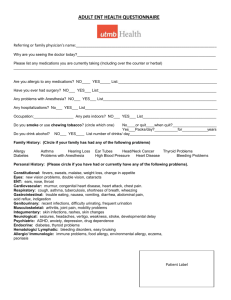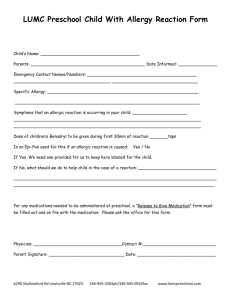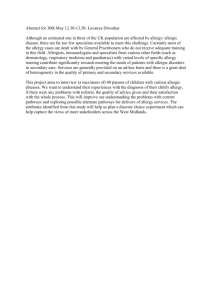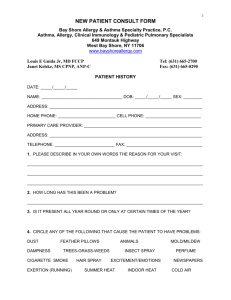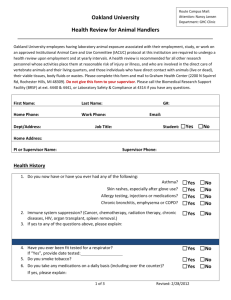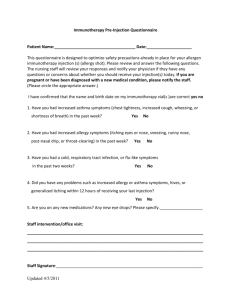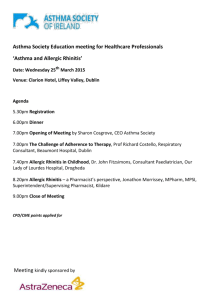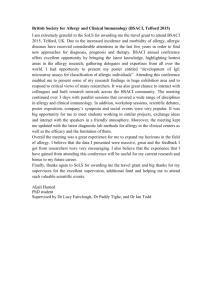ASTHMA PHENOTYPE ALGORITHM Background: Asthma is
advertisement
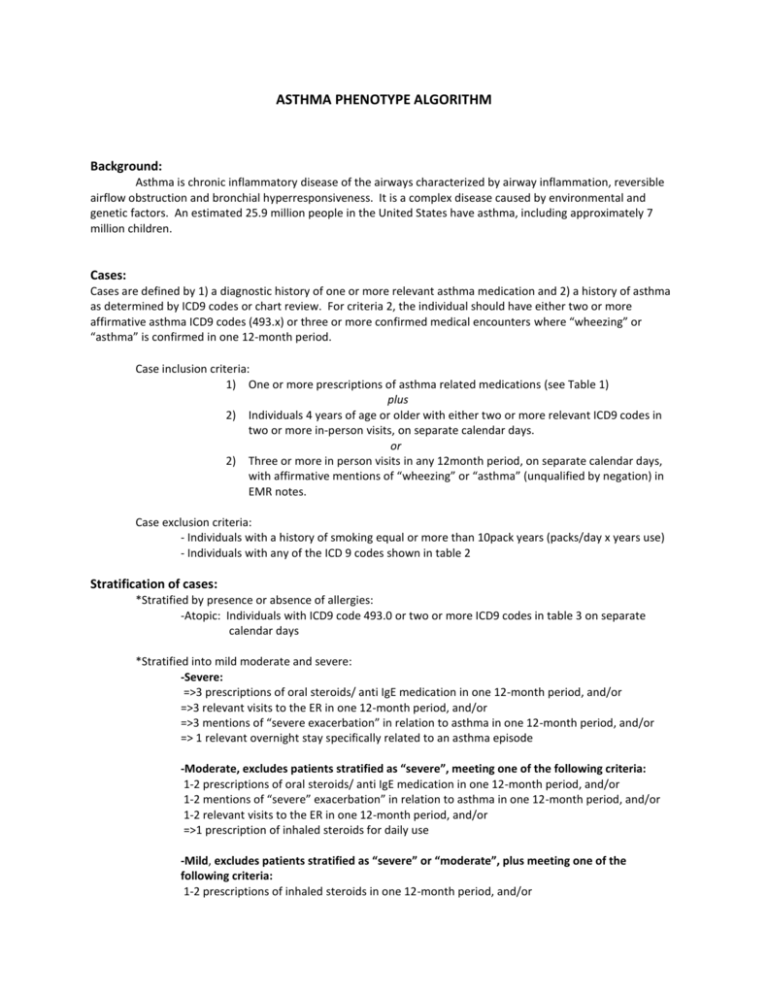
ASTHMA PHENOTYPE ALGORITHM Background: Asthma is chronic inflammatory disease of the airways characterized by airway inflammation, reversible airflow obstruction and bronchial hyperresponsiveness. It is a complex disease caused by environmental and genetic factors. An estimated 25.9 million people in the United States have asthma, including approximately 7 million children. Cases: Cases are defined by 1) a diagnostic history of one or more relevant asthma medication and 2) a history of asthma as determined by ICD9 codes or chart review. For criteria 2, the individual should have either two or more affirmative asthma ICD9 codes (493.x) or three or more confirmed medical encounters where “wheezing” or “asthma” is confirmed in one 12-month period. Case inclusion criteria: 1) One or more prescriptions of asthma related medications (see Table 1) plus 2) Individuals 4 years of age or older with either two or more relevant ICD9 codes in two or more in-person visits, on separate calendar days. or 2) Three or more in person visits in any 12month period, on separate calendar days, with affirmative mentions of “wheezing” or “asthma” (unqualified by negation) in EMR notes. Case exclusion criteria: - Individuals with a history of smoking equal or more than 10pack years (packs/day x years use) - Individuals with any of the ICD 9 codes shown in table 2 Stratification of cases: *Stratified by presence or absence of allergies: -Atopic: Individuals with ICD9 code 493.0 or two or more ICD9 codes in table 3 on separate calendar days *Stratified into mild moderate and severe: -Severe: =>3 prescriptions of oral steroids/ anti IgE medication in one 12-month period, and/or =>3 relevant visits to the ER in one 12-month period, and/or =>3 mentions of “severe exacerbation” in relation to asthma in one 12-month period, and/or => 1 relevant overnight stay specifically related to an asthma episode -Moderate, excludes patients stratified as “severe”, meeting one of the following criteria: 1-2 prescriptions of oral steroids/ anti IgE medication in one 12-month period, and/or 1-2 mentions of “severe” exacerbation” in relation to asthma in one 12-month period, and/or 1-2 relevant visits to the ER in one 12-month period, and/or =>1 prescription of inhaled steroids for daily use -Mild, excludes patients stratified as “severe” or “moderate”, plus meeting one of the following criteria: 1-2 prescriptions of inhaled steroids in one 12-month period, and/or =>1 prescription of beta-agonist -Unclassified, excludes patients stratified as “severe”, “moderate”, or “mild”. Controls: - No diagnosis codes for asthma (493.xx) - No history of relevant medications (see Table 1) - No positive confirmation of “wheezing” or “asthma” in patient chart (NLP) - No exclusionary ICD 9 codes (see Table 4) Covariates: Age Gender Ethnicity BMI Pets Smoking IgE test Positive RAST test Positive rhinoconjuctivitis History of Asthma medications History of Asthma diagnosis Table 1: Asthma medication by sub-type. Oral Steroids, anti-IgE Inhaled Steroids (-> severe) (-> moderate) Dexamethasone Beclomethasone (QVAR) (Decadron, Deltasone) Methylprednisolone Budesonide (Pulmicort (Medrol, Medrol Dosepak) Turbuhaler, Pulmicort Respules) Prednisone (Orasone) Prednisolone (Orapred, Pediapred, Prelone) Triamcinolone (Aristocort) Anti IgE: Omalizumab (Xolair) Flunisolide (Aerobid, Pulmicort Respules) Fluticasone (Flovent), Fluticasone propionate HFA, Fluticasone Propionate inhaled Momethasone (Asmanex Twisthaler) Triamcinolone(Azmacort) Triamcinolone Acetonide Ciclesonide Beta-Agonists (-> mild) β1 agonists Other (-> mild) Mast cell stabilizers Dobutamine Cromolyn (Cromoglicic acid, cromoglycate, cromoglicate, Intal) Cromolyn Sodium Nedocromil (Alocril, Rapitil, Tilade) LeukotrieneAntagonists Epinephrine Racepinephrine Isoproterenol (β1 and β2) Methylxanthine Montelukast Theophylline (aminophylline, Dimethylxanthine, Slo-Bid, Theo, Theodur, Theolair, Uniphyl) Xamoterol Zafirlukast Zileuton β2 agonists Arformoterol (Brovana, Sunovion, ) Albuterol, Albuterol Sulfate (Salbutamol, Ventolin, Proventil, ProAir, Accuneb) Clenbuterol Epinephrine Fenoterol Formoterol (Foradil) Isoetarine Isoproterenol (β1 and β2) Levalbuterol, Levalbuterol HCL, Levalbuterol Tartrate (Levosalbutamol, Xopenex) Metaproterenol Pirbuterol (Maxair) Procaterol Ritodrine Salmeterol (Serevent) Terbutaline (Brethine) Table 2: Asthma Exclusionary ICD9 Codes. ICD-9 Codes 277.xx 478.3xx 490.xx – 492.xx 494.xx 495.2 496.xx 769.xx V81.3 ICD-9 Codes 238.77 996.8 E878.0 V42 V49.83 V58.44 Diagnosis General Cystic Fibrosis Vocal Cord Dysfunction Bronchitis, Emphysema Bronchiectasis, Allergic Alveolitis Bird-fanciers' lung COPD Respiratory Distress Syndrome Chronic bronchitis and emphysema Transplant Diagnosis Post-transplant lymphoproliferative disorder (PTLD) Complications of transplanted organ Surgical operation with transplant of whole organ Organ or tissue replaced by transplant Awaiting organ transplant status Aftercare following organ transplant Table 3: ICD9 Codes Related to Allergies. ICD-9 Codes 287.0 372.14 477 Diagnosis Allergic purpura Other chronic allergic conjunctivitis Allergic rhinitis Ipratropium Bromide Aerovent Apovent Atrovent Ipraxa Phosphodiesterase Inhibitors Ibudilast 495 691.* 708.0 995.3 V14 V15.0 V15.01 V15.03 V15.09 V19.6 Extrinsic allergic alveolitis Atopic dermatitis and related conditions Allergic urticaria Allergy, unspecified Personal history of allergy to medicinal agents Allergy, other than to medicinal agents Allergy to peanuts Allergy to eggs Other allergy, other than to medicinal agents Allergic disorders Table 4 Control Exclusionary ICD9 Codes. ICD-9 Codes 212.3 238.77 277.xx 279.4 283.0 283.1xx 287.0 372.14 416.xx 460 – 466.xx 470 – 478.xx 480 – 488.xx 490 – 492.xx 494 – 496.xx 500.xx-508.xx 510 – 519.xx 525.66 555 556 571.42 708.0 748.4 748.5 751.61 769.xx 995.3 996.8 E878.0 V14 V15.0 V15.01 V15.03 V15.09 V19.6 V42 Diagnosis Bronchus and lung 238.77 Post-transplant lymphoproliferative disorder (PTLD) Cystic Fibrosis Autoimmune disease, not elsewhere classified Autoimmune hemolytic anemias Non-autoimmune hemolytic anemias Allergic purpura Other chronic allergic conjunctivitis Chronic Pulmonary Heart Disease Acute respiratory infections Other diseases of the upper respiratory tract Pneumonia and influenza Diseases of the respiratory system Diseases of the respiratory system Pneumoconiosis Other diseases of the respiratory system Allergy to existing dental restorative material Regional enteritis (Incl. Crohn's disease and Granulomatous enteritis) Ulcerative colitis Autoimmune hepatitis Allergic urticaria Congenital cystic lung Agenesis, hypoplasia, and dysplasia of lung Biliary atresia Respiratory Distress Syndrome Allergy, unspecified Complications of transplanted organ Surgical operation with transplant of whole organ Personal history of allergy to medicinal agents Allergy, other than to medicinal agents Allergy to peanuts Allergy to eggs Other allergy, other than to medicinal agents Allergic disorders Organ or tissue replaced by transplant V49.83 V58.44 Awaiting organ transplant status Aftercare following organ transplant
